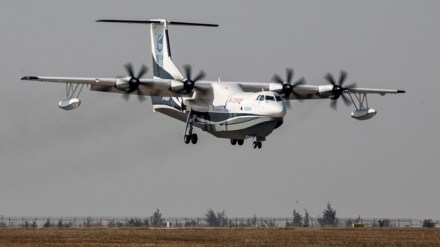By Manish Shukla
The assembly of the AG600 aircraft has picked up pace with the recent arrival of crucial components in Zhuhai, China. The first batch of major parts, including the middle fuselage and wing sections, manufactured by AVIC Xi’an Aircraft, arrived on August 3. This was followed by the delivery of additional components, such as the main launch fairing, guard plate, and dorsal fin, produced by Aviation Industry General Aviation North China Company on August 5.
Significantly, the AG600 has successfully completed the manufacturing conformity inspection, marking a critical milestone in its assembly process. With these developments, the AG600 aircraft is one step closer to completion, underscoring China’s progress in aircraft manufacturing.
The AG600, manufactured by the state-owned Aviation Industry Corporation of China (AVIC), is the world’s largest amphibious aircraft, boasting an impressive payload capacity of 50 troops or 12 tons of equipment. Designed for diverse military applications, including search and rescue, patrolling, and transportation of personnel, supplies, arms, and ammunition, this aircraft is a vital asset for the Chinese People’s Liberation Army (PLA).
The AG600’s capabilities enable it to rapidly respond to situations in the South China Sea, reaching any location within hours from coastal mainland bases such as Zhuhai or Hainan. This aircraft is a key component of China’s strategy to enhance its military aviation capabilities, along with the indigenous Y-20 military transport plane. The AG600’s development underscores China’s commitment to expanding its military reach and responsiveness.
The AG600’s versatility in landing on both land and water makes it an ideal aircraft for accessing remote and hard-to-reach areas with speed and efficiency. Its capabilities enable rapid mobilization of troops, equipment, arms, and ammunition to any island or amphibious warfare zone.
In the Context of India: A Strategic Edge
The AG600 poses significant implications for India, particularly in the Eastern Ladakh region. The aircraft’s ability to land on large natural lakes like Pangong Tso enables the PLA to quickly mobilize troops, supplies, and equipment, gaining a strategic advantage in terms of time and space. This capability allows the PLA to rapidly build up its forces, potentially outpacing Indian deployments and providing an upper hand in operational responsiveness. The AG600’s amphibious capabilities thus represent a critical asset for the PLA in the region.
In the strategic context of the South China Sea and East China Sea, the Chinese military can harness the capabilities of the AG 600 amphibious aircraft in several significant ways. The AG 600 can provide continuous monitoring of the vast maritime area, tracking shipping lanes, and enforcing Chinese territorial claims. It can collect valuable intelligence on foreign military movements and activities, enhancing situational awareness and enabling informed decision-making. The aircraft can swiftly deploy troops and equipment to disputed islands, reefs, and shoals, reinforcing Chinese positions and responding to incursions. Operating from both sea and land, using temporary bases and ships, the AG 600 increases strategic mobility and response times, allowing the Chinese military to project power more effectively. By leveraging the AG 600’s capabilities, China can strengthen its position in the region, assert its territorial claims, and enhance its military presence.
The AG 600 aircraft is capable of performing a range of critical tasks. It can conduct Search and Rescue Operations for both military and civilian vessels in distress, enhancing China’s response to maritime emergencies. The aircraft provides logistical support to remote islands and outposts by delivering essential supplies, equipment, and personnel, reducing reliance on traditional naval supply chains. It can also deliver humanitarian aid and medical assistance to areas affected by natural disasters or other emergencies, enabling rapid response and relief efforts. Furthermore, the AG 600 can deploy sonar buoys and other Anti-Submarine Warfare equipment to detect and track submarines in the complex waters of the South China Sea, bolstering China’s maritime surveillance capabilities. Overall, the AG 600 aircraft is a versatile asset that can significantly enhance China’s ability to respond to various maritime scenarios, from emergencies to military operations.
The AG 600 amphibious aircraft can play a vital role in supporting China’s maritime interests. They can enforce Chinese maritime laws and regulations through coast guard and maritime militia operations, asserting sovereignty over contested waters. The presence of these aircraft can serve as a deterrent to other nations’ activities, reinforcing China’s claims and strategic interests.
The AG 600 can also facilitate the expansion and maintenance of artificial islands by transporting construction materials and personnel, ensuring continuous operational readiness of these outposts through reliable supply lines. Additionally, they can enhance the operational capability of the Chinese navy by working in tandem with naval forces, extending the reach of surface vessels.
Operating from ships and seaplane tenders, the AG 600 can provide additional operational bases and flexibility for joint military operations. Overall, the AG 600 amphibious aircraft can significantly enhance China’s strategic and operational capabilities in the South China Sea, offering flexibility, rapid response, and sustained presence in a highly contested and strategically vital region.
(With nearly two decades in Journalism, the author is a n independent journalist. His expertise is in covering a wide range of crucial subjects, including internal security, terror-related cases, Jammu and Kashmir, India-Pakistan relations, and India-China relations.)
(Disclaimer: Views expressed are personal and do not reflect the official position or policy of FinancialExpress.com Reproducing this content without permission is prohibited.)
